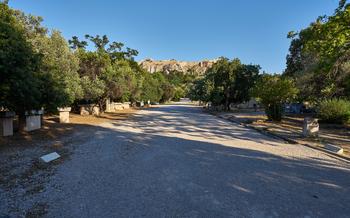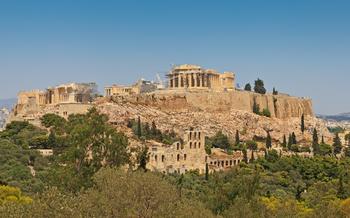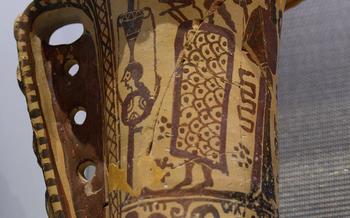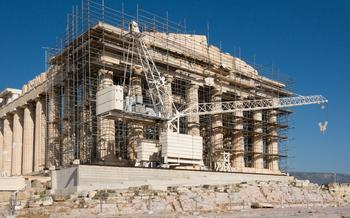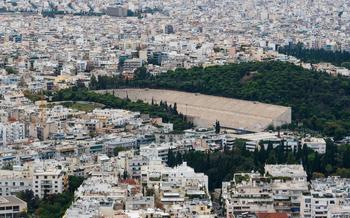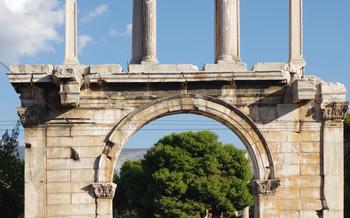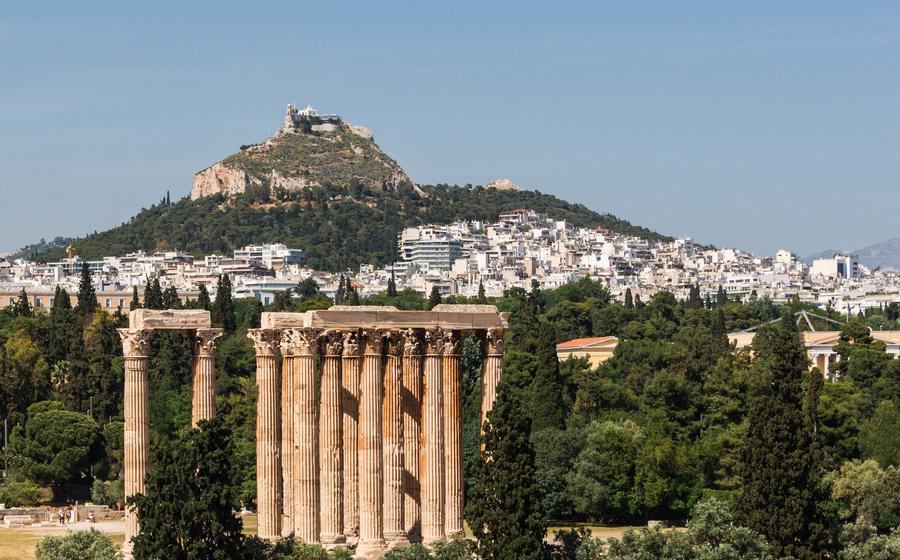
Temple of Olympian Zeus
- Location and Transportation
- Guided Tours and Audio Guides
- Exploring the Temple Grounds
- Historical Context and Mythology
- Architectural Marvels
- Surviving Sculptures and Artifacts
- Temple's Decline and Destruction
- Restoration and Archaeological Work
- Temple as a Symbol of Resilience
- Surrounding Area and Attractions
- Photography and Social Media
- Insider Tip: Unveiling Hidden Gems
Temple of Olympian Zeus: Embodiment of Divine Majesty
At the heart of Athens, nestled among ancient ruins and modern marvels, stands the Temple of Olympian Zeus, a testament to the grandeur and devotion of the ancient Greek civilization. Dedicated to Zeus, the king of the Olympian gods, this colossal temple was conceived as a symbol of awe-inspiring power and religious devotion.
Its construction began in the 6th century BC under the rule of Peisistratos, with the ambition to create a temple of unprecedented scale and magnificence. However, it wasn't until the 2nd century AD, under the Roman emperor Hadrian, that the temple was finally completed, marking a remarkable feat of architectural achievement that would leave an enduring legacy.
The Temple of Olympian Zeus stands as a testament to the architectural prowess of the ancient Greeks. Its sheer size and grandeur are awe-inspiring, showcasing the mastery of Greek engineering and design. The temple's massive columns, intricate carvings, and towering pediments invoke a sense of divine presence, creating an atmosphere of reverence and wonder.
Despite the ravages of time and natural disasters, the Temple of Olympian Zeus remains a significant landmark, attracting visitors from around the world. Its enduring presence serves as a reminder of the enduring legacy of ancient Greece and the enduring power of human devotion.
Location and Transportation
The Temple of Olympian Zeus stands proudly in the heart of Athens, Greece, at a site known as the Olympieion. It is situated in the city center, within walking distance of many other popular attractions. To reach the temple, visitors can take advantage of Athens' well-connected public transportation system.
The closest metro station to the temple is Akropoli, served by Line 2 (red line). From the station, it is a short walk of approximately 5-7 minutes to reach the temple entrance. The temple is also accessible by bus, with several lines stopping nearby. Visitors can refer to the official website of the Athens Transport Authority (OASA) for detailed information on bus routes and stops.
For those who prefer a more leisurely approach, taking a taxi or ride-sharing service is a convenient option. Taxis can be hailed on the street or arranged through a mobile app. Visitors should note that the temple is located in a busy area, so traffic congestion is possible, especially during peak hours.
The temple is wheelchair accessible, with ramps and designated parking spaces available. Visitors with disabilities can request assistance from the temple staff if needed.
Guided Tours and Audio Guides
The Temple of Olympian Zeus offers guided tours that provide in-depth insights into its history, architecture, and significance. These tours are led by experienced and knowledgeable guides who bring the temple's stories to life. Visitors can choose from various languages, including English, French, German, and Spanish, to ensure a comfortable and engaging experience.
The cost of guided tours typically ranges from 10 to 15 euros per person, depending on the group size and the language of the tour. Group discounts are often available for larger groups, making it an economical option for families and friends traveling together.
For those who prefer a self-guided tour, audio guides are available in multiple languages at a rental fee of approximately 5 euros. These audio guides offer a comprehensive commentary on the temple's history, features, and mythology, allowing visitors to explore the site at their own pace and convenience.
Exploring the Temple Grounds
As you approach the Temple of Olympian Zeus, its massive scale and imposing presence become evident. The sprawling temple complex encompasses an extensive area, inviting you to embark on a journey through ancient history and architectural wonders.
The layout of the temple grounds is meticulously designed, showcasing the grandeur and significance of this sacred site. At the heart of the complex lies the colossal temple itself, surrounded by a vast expanse of open space. This arrangement allows visitors to fully appreciate the temple's sheer size and admire its architectural details from various vantage points.
As you wander through the grounds, take note of the majestic columns that line the temple's perimeter. These towering columns, standing over 17 meters tall, are a testament to the incredible engineering and craftsmanship of the ancient Greeks. Each column features intricate carvings and embellishments, contributing to the temple's overall beauty and grandeur.
Pay close attention to the pediments, the triangular gables located at the front and back of the temple. These elaborate sculptural compositions depict scenes from Greek mythology, showcasing the artistic prowess of the ancient Greeks. Although some of the sculptures have been lost or damaged over time, the remaining fragments offer a glimpse into the rich storytelling and symbolism that adorned the temple.
Navigating the temple grounds is relatively straightforward. Well-defined pathways and walkways guide visitors through the complex, ensuring a safe and accessible experience. However, be prepared to encounter some steps and slopes as you explore the site, particularly when accessing the temple's elevated platform.
Historical Context and Mythology
In Greek mythology, Zeus was the king of the gods and goddesses, ruling from Mount Olympus. He was revered for his power, wisdom, and justice. The Temple of Olympian Zeus was built in his honor, reflecting his importance in the religious and political landscape of ancient Greece.
The temple's construction began in the 6th century BCE under the rule of Peisistratos, a powerful Athenian tyrant. However, due to political turmoil and financial constraints, it remained unfinished for centuries. It was not until the reign of Roman Emperor Hadrian in the 2nd century CE that the temple was finally completed, nearly 700 years after its initial construction.
Once completed, the temple was a marvel of ancient architecture, symbolizing the might and majesty of Zeus. It served as a religious center for the people of Athens, hosting grand festivals and ceremonies in honor of the supreme god. The temple was also a symbol of Athenian power and prosperity, showcasing the city's wealth and cultural achievements.
Architectural Marvels
The Temple of Olympian Zeus stands as a testament to the architectural prowess of ancient Greece. Its colossal dimensions and scale are awe-inspiring, with a length of 412 feet and a width of 230 feet. The temple's 104 massive Corinthian columns, each standing 56 feet tall, are a sight to behold. These columns, with their intricate capitals adorned with acanthus leaves and scrolls, represent the pinnacle of Greek architectural design.
The temple's pediments, or triangular gables, were once adorned with elaborate sculptures depicting mythological scenes. Although these sculptures have been lost to time, their fragments offer a glimpse into the temple's former glory. The east pediment depicted the birth of Zeus, while the west pediment showcased the battle between the Olympian gods and the giants.
The temple's frieze, a continuous band of sculptures that ran along the top of the cella walls, also showcased intricate carvings depicting scenes from Greek mythology. These sculptures, which depicted the twelve labors of Hercules, the battle of the Lapiths and the Centaurs, and the wedding of Zeus and Hera, offered a visual narrative of the gods' stories.
The combination of these architectural elements created a harmonious and awe-inspiring structure that reflected the power and majesty of Zeus, the king of the gods.
Surviving Sculptures and Artifacts
The Temple of Olympian Zeus once boasted an array of exquisite sculptures and artifacts that adorned its vast interior and exterior. Although many of these treasures have been lost to the ravages of time and looting, a few notable pieces remain, offering a glimpse into the artistic prowess of ancient Greece.
One of the most famous surviving sculptures is the colossal head of Zeus, which now resides in the British Museum. Measuring over five feet in height, this awe-inspiring marble masterpiece portrays the king of the gods with a serene and majestic countenance. The head is believed to have once crowned a colossal statue of Zeus that stood within the temple's cella, towering over the worshippers below.
While the majority of the temple's original sculptures have been lost or destroyed, fragments and replicas can be found in various museums and collections around the world. The Acropolis Museum in Athens houses a collection of metopes, or decorative panels, that once adorned the temple's exterior. These metopes depict various mythological scenes, including the battle between the gods and the giants, and offer valuable insights into the rich iconography of the temple.
Despite the passage of time and the ravages of history, the surviving sculptures and artifacts from the Temple of Olympian Zeus continue to captivate and inspire. They serve as tangible links to the past, allowing us to glimpse the grandeur and artistry of this once-magnificent temple.
Temple's Decline and Destruction
The Temple of Olympian Zeus, once a majestic symbol of Greek power and devotion, gradually fell into decline and ruin over the centuries. Several factors contributed to its downfall, including natural disasters, looting, and the changing political and religious landscape of ancient Greece.
The temple's location in a seismically active region made it vulnerable to earthquakes. Over time, powerful tremors caused significant damage to the structure, weakening its foundations and toppling some of its columns. Fires and riots further contributed to its deterioration, leaving behind charred remains and shattered fragments.
As the Roman Empire gained influence in Greece, the religious significance of the temple diminished. The rise of Christianity and the decline of pagan beliefs led to the abandonment of the temple as a place of worship. Its once-sacred statues and ornaments were looted and plundered, scattered across various collections and museums.
With the passage of time, the temple became a source of building materials for other constructions in the city. Its colossal columns were quarried and reused in various projects, leaving behind only a fraction of its original grandeur. The once-towering edifice was reduced to a collection of ruins, a testament to the passage of time and the vagaries of history.
Restoration and Archaeological Work
The Temple of Olympian Zeus has undergone extensive restoration efforts in recent years, aiming to preserve and protect this iconic landmark. Archaeologists and conservators have worked tirelessly to restore damaged columns, reinforce structural elements, and uncover new insights into the temple's history.
One of the most significant challenges in restoring the temple lies in sourcing authentic materials that match the original construction. To ensure historical accuracy, restorers have meticulously studied ancient quarries and sought out similar types of marble for repairs. This painstaking process helps maintain the temple's integrity and authenticity.
Archaeological excavations around the temple have also yielded exciting discoveries, shedding light on its past and significance. Unearthed artifacts, such as sculptures, inscriptions, and pottery fragments, have provided valuable clues about the temple's construction phases, religious rituals, and the daily lives of ancient Athenians.
The ongoing restoration work at the Temple of Olympian Zeus is a testament to the dedication and expertise of archaeologists and conservators. Their efforts not only preserve this architectural marvel for future generations but also contribute to our understanding of ancient Greek history and culture.
Temple as a Symbol of Resilience
The Temple of Olympian Zeus stands as a testament to the endurance and resilience of the human spirit. Despite the ravages of time, natural disasters, and human destruction, the temple's ruins continue to inspire awe and wonder in visitors from around the world. Its enduring legacy symbolizes the strength and fortitude of the Greek people and their rich cultural heritage.
The temple's ability to withstand the test of time is a reminder that even in the face of adversity, beauty and resilience can prevail. It serves as a symbol of hope and perseverance, demonstrating that even when structures crumble and empires fall, the spirit of a people can endure.
Preserving the Temple of Olympian Zeus is not just about protecting a historical site; it is about safeguarding a symbol of resilience and a reminder of the enduring power of the human spirit. By protecting this ancient monument, we honor the legacy of those who came before us and ensure that future generations can continue to marvel at its grandeur and draw inspiration from its story.
Surrounding Area and Attractions
The Temple of Olympian Zeus is situated in a vibrant and historically rich neighborhood of Athens. Its proximity to several notable landmarks and attractions makes it an ideal starting point for exploring the city's ancient heritage. A short walk from the temple, visitors can admire the grandeur of Hadrian's Arch, a triumphal arch built by the Roman emperor Hadrian in 131 AD to commemorate his victory over the Athenians. Just beyond the arch lies the Panathenaic Stadium, also known as the Kallimarmaro, which was the site of the ancient Olympic Games and has been restored to host modern sporting events.
In the vicinity of the temple, visitors can find a variety of dining options to suit every taste. From traditional Greek tavernas serving mouthwatering dishes like moussaka and pastitsio to modern cafes offering a contemporary culinary experience, there are plenty of places to grab a bite to eat or enjoy a refreshing beverage.
Combining a visit to the Temple of Olympian Zeus with other activities in the surrounding area allows visitors to immerse themselves in the rich history and culture of Athens. Whether it's exploring the ancient ruins of the Acropolis, strolling through the bustling streets of Plaka, or taking a leisurely walk through the National Gardens, there's something for everyone to enjoy within easy reach of the temple.
Photography and Social Media
The Temple of Olympian Zeus is a majestic sight that deserves to be captured and shared. With its towering columns and intricate details, the temple offers countless opportunities for stunning photographs. Bring your camera and take your time to explore the grounds, experimenting with different angles and perspectives. Whether you're a professional photographer or simply enjoy taking snapshots, you'll find plenty of Instagram-worthy moments here.
Once you've captured your memories, don't forget to share them with the world on social media. Use hashtags like #TempleOfOlympianZeus, #Athens, and #Greece to connect with other travelers and share your experiences. Tagging the official social media accounts of the temple or the Greek Ministry of Culture can also help you reach a wider audience and promote the preservation of this iconic landmark.
Insider Tip: Unveiling Hidden Gems
Beyond the iconic façade of the Temple of Olympian Zeus, there are hidden spots and lesser-known attractions that await discovery. Venture to the back of the temple complex, where you'll find a serene garden adorned with ancient olive trees. This peaceful oasis offers a unique perspective of the temple's towering ruins, casting a picturesque backdrop for capturing memorable photos.
For a truly immersive experience, explore the surrounding neighborhood of Plaka. Wander through its charming streets and stumble upon hidden gems like the Anafiotika neighborhood, known for its whitewashed houses and panoramic views of the Acropolis. Immerse yourself in the local culture by visiting traditional tavernas, where you can savor delicious Greek cuisine and mingle with friendly locals.
Plaka also boasts several intriguing museums, such as the Benaki Museum, housing an extensive collection of Greek history and art, and the Jewish Museum of Greece, which delves into the rich heritage of the Jewish community in Greece. These hidden gems offer a deeper understanding of Athens' diverse past and present.
Remember to share your unique experiences with the world through social media. Tag your photos with #TempleOfOlympianZeus and #Athens to connect with fellow travelers and inspire others to uncover the hidden treasures of this ancient city.



